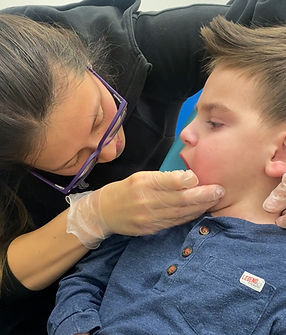5970 Centre St S, Unit 100 Calgary, AB, T2H0C1
Formerly known as SMILE Therapy for Kids Calgary
Help us fundraise for a medium Trexo Robot
Pediatric Occupational Therapy

About Occupational Therapy
Occupational therapy can assist with acquiring or reacquiring function in physical, sensory and/or cognitive abilities. Although, traditionally, it is linked to assisting with a particular 'occupation' (i.e. buttoning of a button, putting on of shoes, self-feeding, writing, etc.), at Canadian Centre for Development, we take Occupational Therapy beyond that, to look at the child more holistically.
How Occupational Therapy Works
At the Canadian Centre for Development we look at the child as a whole, body and brain, and ensure that no part is treated in isolation. We do this by paying special focus to the two sensory systems that are most often overlooked: vestibular and proprioceptive. These are the systems that help our brain understand where our body is in space and what needs to be done with it. The vestibular system is located in the inner ear and is our balance system. The proprioceptive system grounds us and makes us feel secure. A good example is one where if one were to lose their balance and be falling, the vestibular system is the one that would prompt us to wave our arms to try to find our balance, and the proprioceptive system is the one that would lead us to want to grab onto something to stabilize ourselves. Without the united functionality of both of these systems, the learning of additional skills, especially those that throw our centre of gravity off balance, are next to impossible.
Our occupational therapists also actively work on life skills (ie. dressing, toileting, self-feeding, etc), fine-motor skills (ie. writing, cutting, buttoning, etc), oral motor skills (ie. chewing, moving food around the mouth, drinking, etc.) and many others.


Who Can Benefit from Occupational Therapy
Although, traditionally, occupational therapy focuses on fine-motor function and alignment, at the Canadian Centre for Development, all of our children can benefit from seeing our Occupational Therapist. We find that combining Occupational Therapy with other therapies, like pediatric physiotherapy or speech therapy, is always beneficial, as they're very complementary, and especially since our OT practice is much more holistic in nature than what families would find in most other settings.
How is Occupational Therapy Delivered
We don't have a cookie cutter model at Canadian Centre for Development, and how our therapies are delivered vary greatly with each child and that child's goals. Some tools that may be used during an Occupational Therapy session are:
-
Therapy balls of various sizes
-
Astronaut board
-
Swings
-
Squigz
-
Play balls and other toys
-
Therapy bands
-
Crash pad
-
Wedges and blocks
-
Z-vibe
-
Straws
-
Chewables
-
Foods brought from home
-
Sensory bins
-
Games and toys
-
Gaiters
.png)
Occupational Therapy Approaches
OTs will work alongside your family to guide and provide support to implement strategies in order to help your child achieve their goals. OTs will assess your child’s skill, the task that they want or need to do as well as their environment to ensure all aspects of your child’s life are helping facilitate skill development. Below are some common areas OTs provide support in and also what theories, approaches, protocols they may draw from in order to best support your child. Please note that this list below is not limited to all target areas. Your OT will work alongside you to develop a specific plan to fit your child’s needs.




